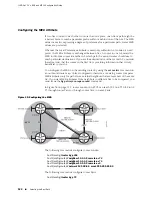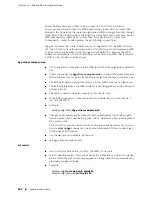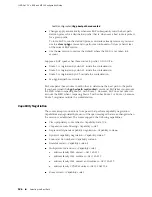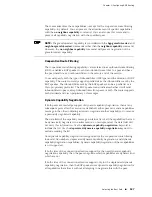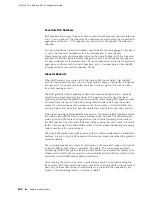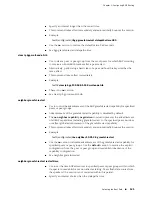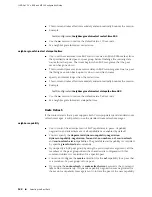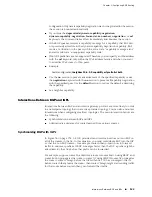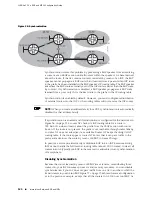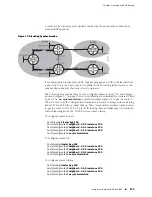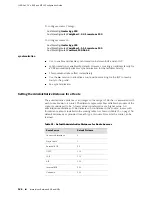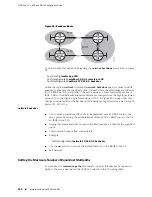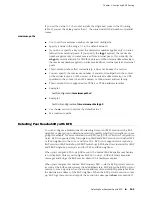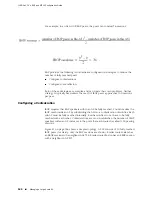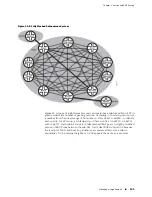
Figure 36: Synchronization
Synchronization solves this problem by preventing a BGP speaker from advertising
a route over an EBGP session until all routers within the speaker’s AS have learned
about the route. If the AS contains routers connected by means of an IGP, the BGP
speaker cannot propagate a BGP route that it learned from a peer until an IGP route
to the prefix has been installed in the BGP speaker’s IP routing table. The BGP speaker
advertises the BGP route externally even if the IGP route is better than the BGP route.
By contrast, if synchronization is disabled, a BGP speaker propagates a BGP route
learned from a peer only if it is the best route to the prefix in the IP routing table.
Synchronization is enabled by default. However, you must configure redistribution
of external routes into the IGP, or the routing tables will not receive the IGP routes.
NOTE:
When you create an address family for a VRF, synchronization is automatically
disabled for that address family.
If synchronization is enabled and if redistribution is configured for the networks in
Figure 36 on page 134, router NY checks its IGP routing table for a route to
192.56.0.0/16 when it learns about the prefix from the IBGP session with router
Boston. If the route is not present, the prefix is not reachable through router Albany,
so router NY does not advertise it as available. Router NY keeps checking its IGP
routing table; if the route appears, router NY knows that it can pass traffic to the
prefix and advertises the route by means of EBGP to router Chicago.
In practice, service providers rarely redistribute BGP into an IGP because existing
IGPs cannot handle the full Internet routing table (about 100,00 routes). Instead, all
routers in an AS typically run BGP; in these cases it is advisable to turn synchronization
off everywhere.
Disabling Synchronization
Because the routes learned by means of EBGP are extensive, redistributing those
routes into your IGP consumes processor and memory resources. You can disable
synchronization if your AS does not pass traffic from one AS to another or if all the
transit routers in your AS run BGP. Figure 37 on page 135 shows the same configuration
as in the previous example, except that all the routers in AS 100 now run IBGP. As
134
■
Interactions Between BGP and IGPs
JUNOSe 11.1.x BGP and MPLS Configuration Guide
Summary of Contents for BGP
Page 6: ...vi ...
Page 8: ...viii JUNOSe 11 1 x BGP and MPLS Configuration Guide ...
Page 37: ...Part 1 Border Gateway Protocol Configuring BGP Routing on page 3 Border Gateway Protocol 1 ...
Page 38: ...2 Border Gateway Protocol JUNOSe 11 1 x BGP and MPLS Configuration Guide ...
Page 234: ...198 Monitoring BGP JUNOSe 11 1 x BGP and MPLS Configuration Guide ...
Page 236: ...200 Multiprotocol Layer Switching JUNOSe 11 1 x BGP and MPLS Configuration Guide ...
Page 542: ...506 Monitoring BGP MPLS VPNs JUNOSe 11 1 x BGP and MPLS Configuration Guide ...
Page 544: ...508 Layer 2 Services Over MPLS JUNOSe 11 1 x BGP and MPLS Configuration Guide ...
Page 610: ...574 Virtual Private LAN Service JUNOSe 11 1 x BGP and MPLS Configuration Guide ...
Page 624: ...588 VPLS References JUNOSe 11 1 x BGP and MPLS Configuration Guide ...
Page 680: ...644 Virtual Private Wire Service JUNOSe 11 1 x BGP and MPLS Configuration Guide ...
Page 724: ...688 Monitoring MPLS Forwarding Table for VPWS JUNOSe 11 1 x BGP and MPLS Configuration Guide ...
Page 725: ...Part 6 Index Index on page 691 Index 689 ...
Page 726: ...690 Index JUNOSe 11 1 x BGP and MPLS Configuration Guide ...



